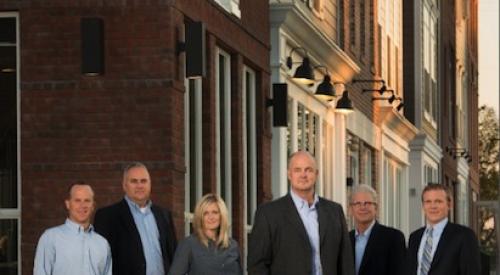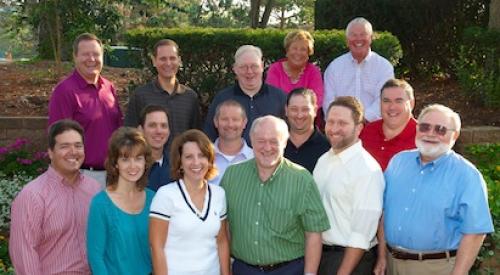|
Although sales of manufactured homes surged in the late 1990s because of a loosening of financing restrictions, the slowing economy has caused repossession rates to shoot up. Many companies that had ramped up to meet demand were left with new factories and few orders. The Census Bureau reports a 100,000-unit drop in 2000 from the 1998 high of 373,700 manufactured housing units placed nationally.
| Director of engineering Tom Brandt reviews new home orders with plant superintendent Steve Maisonneuve and assistant supervisors Nathan Yoder and Josh Isbell. Maisonneuve's plant decreased cycle times by 22% using lean manufacturing methods, team-based problem solving and increased employee training. |
Success in good years is tough enough, but success in the face of a declining market is the sign of a tightly run, strategically driven company. NHQ Silver Award winner Fairmont Homes in Nappanee, Ind., is one such company. In 2001 it reduced cycle time by 20%, lowered repetitive defects by almost 75% and increased its market share by 5.57%. Fairmont traces these improvements to three key initiatives employee involvement, learning organization and lean manufacturing that are frequently intertwined as Fairmont goes after its goals.
In the pursuit of lean manufacturing, for instance, Fairmont employees use the 5s system a Japanese method for increasing efficiency and reducing waste to evaluate, streamline and standardize work processes, be it on the factory floor or in the corporate office. The task of reordering each work process never could have been completed without involving representatives of all affected employees, who in turn needed to be trained in using the 5s system and working in a team environment.
While Fairmont's achievements overall are many, the NHQ judges held up some of its practices in employee involvement and education as best practices in the industry and as key to its NHQ Silver Award.
| Instant gratification: Employees receive Fairmont coins, redeemable at the lunch truck, for continuous improvement actions spotted by a supervisor. |
Employee Teams Drive Improvement
As Fairmont's executive team sought ways to strengthen the company in the face of a declining market, it identified employees' intellectual potential as Fairmont's most promising, yet untapped, resource.
"We'd lost our edge," CEO Jim Shea says. "We'd always had some of the best facilities for our industry, but a lot of companies had caught up. We decided we could make the biggest improvement by improving the human capital. We needed to educate ourselves and our work force so we could pull on the collective intelligence of our people on a far better basis than we had been."
To begin that process, the executive team decided to shift from a strictly hierarchical management structure to a team-based approach.
Now the company is organized with two types of teams: standing teams that exist on an ongoing basis and project teams that dissolve when a specific task is completed. What makes both types work is that the teams consist of cross-functional members. All teams must establish goals, regularly report processes, and modify goals or action plans as necessary all of which is tracked on a formalized computer system.
For instance, to resolve a problem in the plumbing area of the factory floor, someone in accounts payable, an administrator and a supplier might join plumbing production employees in applying 5s methodology and W. Edwards Deming's plan-do-check-act model.
Shifting to a team-based organization driven by employee input and feedback is not easy and is fraught with danger. Shea cites an RV company that embarked upon it without providing training in leading in that environment, nor on working as a team member.
"They just had more people making bad decisions faster," says Shea. "The other concern is ending up with a bureaucratic stultification or gridlock. It's easy to get too much good medicine." "It is upper management's responsibility to provide the training to maintain the right balance so you can get the best from the medicine instead of letting the medicine become a problem."
Shea says he had skeptics when he started the program seven years ago, but now employees grasp the "what's in it for me" factor and feel a sense of empowerment, respect and dignity.
Line operators are trained in customer focus, group dynamics, managing meetings (including agendas, minutes and roles), the improvement process and problem-solving tools.
First-line supervisors get additional training in team development, styles of management, train-the-trainer and roles of the facilitator.
Assessing the Returns
Fairmont's return on investment in education and other culture and system improvements is tied to its ability to meet companywide goals with a well-trained, empowered work force.
The results of Fairmont's three-pronged commitment speak for themselves. The company has reduced scrap by 11%, waste-removal cost by 15% and material costs by 4%. It also has experienced a 26% improvement in inventory turns.
Current goals include a reduction in turnover by 3-5% annually, a 90% safety rating, a 15% reduction in administrative costs, 40 hours of training per person and a 15% reduction in workers' compensation costs.












